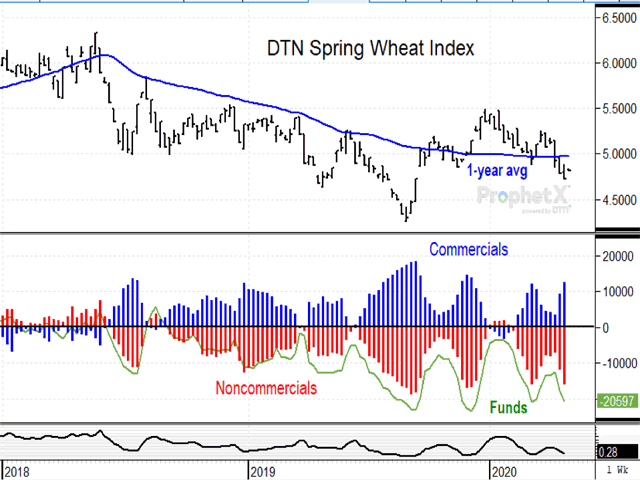Todd's Take
Spring Wheat's Bullish Potential
In a year dominated by coronavirus concerns, it has been difficult to find a grain price with much bullish potential. One of the first things I look for when prices turn cheap is a bullish response from commercial traders.
Unlike the typical speculator, commercials recognize value and have enough insight about demand to know a bargain when they see one. As of April 28, commercials were net long in corn, canola and Minneapolis spring wheat. Of the three, I find spring wheat the most interesting in 2020 because of wheat's ability to largely ignore the ups and downs of economic worries. Wheat demand is largely a function of population growth, a statistic that coronavirus is not big enough to significantly hurt.
According to USDA, 29% of the U.S. spring wheat crop was planted as of May 3, a slower-than-normal start compared to a five-year average of 43%. As DTN Basis Analyst Mary Kennedy described in the Market Matters Blog on May 3 (see https://www.dtnpf.com/… ), North Dakota has had an especially difficult time this year with wet fields, frost in the ground and 2019 corn crops still being harvested. USDA said 15% of North Dakota's spring wheat crop was planted, down from a five-year average of 33%.
North Dakota was last year's largest spring wheat producer, accounting for over half of the country's total crop. As DTN Staff Reporter Emily Unglesbee explained on May 6, young wheat crops tend to tolerate freezing temperatures up until boot stage (https://www.dtnpf.com/… ). It is worth noting that morning temperatures are expected to dip into the 20s in North Dakota on Friday through Tuesday.
P[L1] D[0x0] M[300x250] OOP[F] ADUNIT[] T[]
Minnesota was the third largest spring wheat producer in 2019, behind Montana. Only 21% of Minnesota's spring wheat crop was planted by May 3, down from the five-year average of 45%. Minnesota also has a risk of subfreezing temperatures over the next several days. Even if the young wheat survives the upcoming cold snap, there are enough difficulties on the ground to suspect USDA's March estimate of 12.59 million acres of spring wheat plantings won't be reached this year.
I point out spring wheat's early difficulties because, while much of the crop has yet to be planted, managed futures funds have already made a large bet on spring wheat prices going lower in 2020. The most recent Commitments of Traders report showed managed futures funds net short 20,597 contracts of Minneapolis wheat, one of the largest bearish bets on record.
The same report showed 72% of noncommercial positions on the short side of the market, a level of bearish confidence seldom seen. Meanwhile, USDA's Commodity Costs and Returns ( https://www.ers.usda.gov/… ) estimates the cost of growing wheat in the Northern Great Plains at $330.23 an acre or roughly $5.90 a bushel for spring wheat.
DTN's National Spring Wheat Index settled at $4.81 a bushel on Thursday, May 6, substantially below USDA's cost estimate. Just how much lower speculators think spring wheat will go or why they think prices will go there is difficult to explain.
As I have explained many times before, when commercial positions widely differ with noncommercial positions, as they currently do for spring wheat, it is the commercial money that typically wins the argument.
Fundamentally speaking, I don't know yet what might spark buying in spring wheat in 2020, but there are plenty of risks ahead. The upcoming cold snap in the Northern Plains may or may not be this year's bullish trigger, and I can never be 100% certain, but this is one bearish bet I expect the funds to lose.
Todd Hultman can be reached at Todd.Hultman@dtn.com
Follow him on Twitter @ToddHultman
(c) Copyright 2020 DTN, LLC. All rights reserved.




